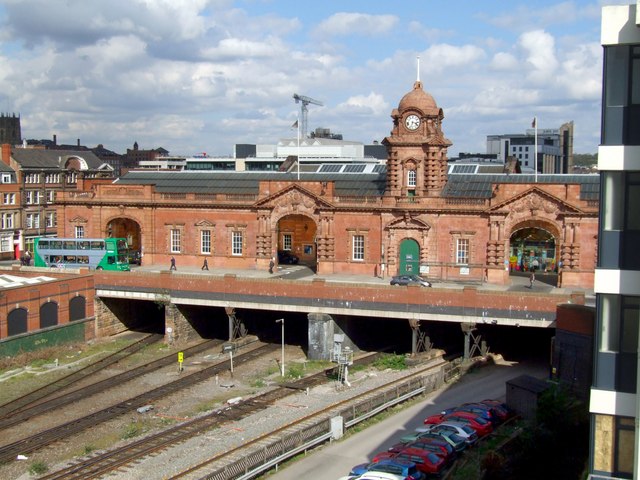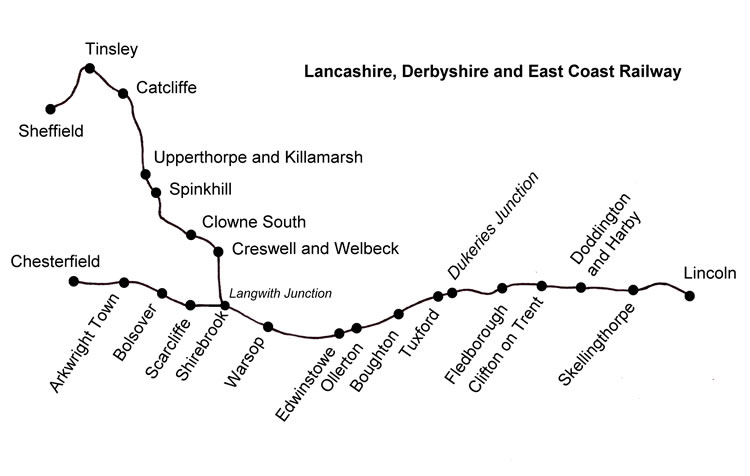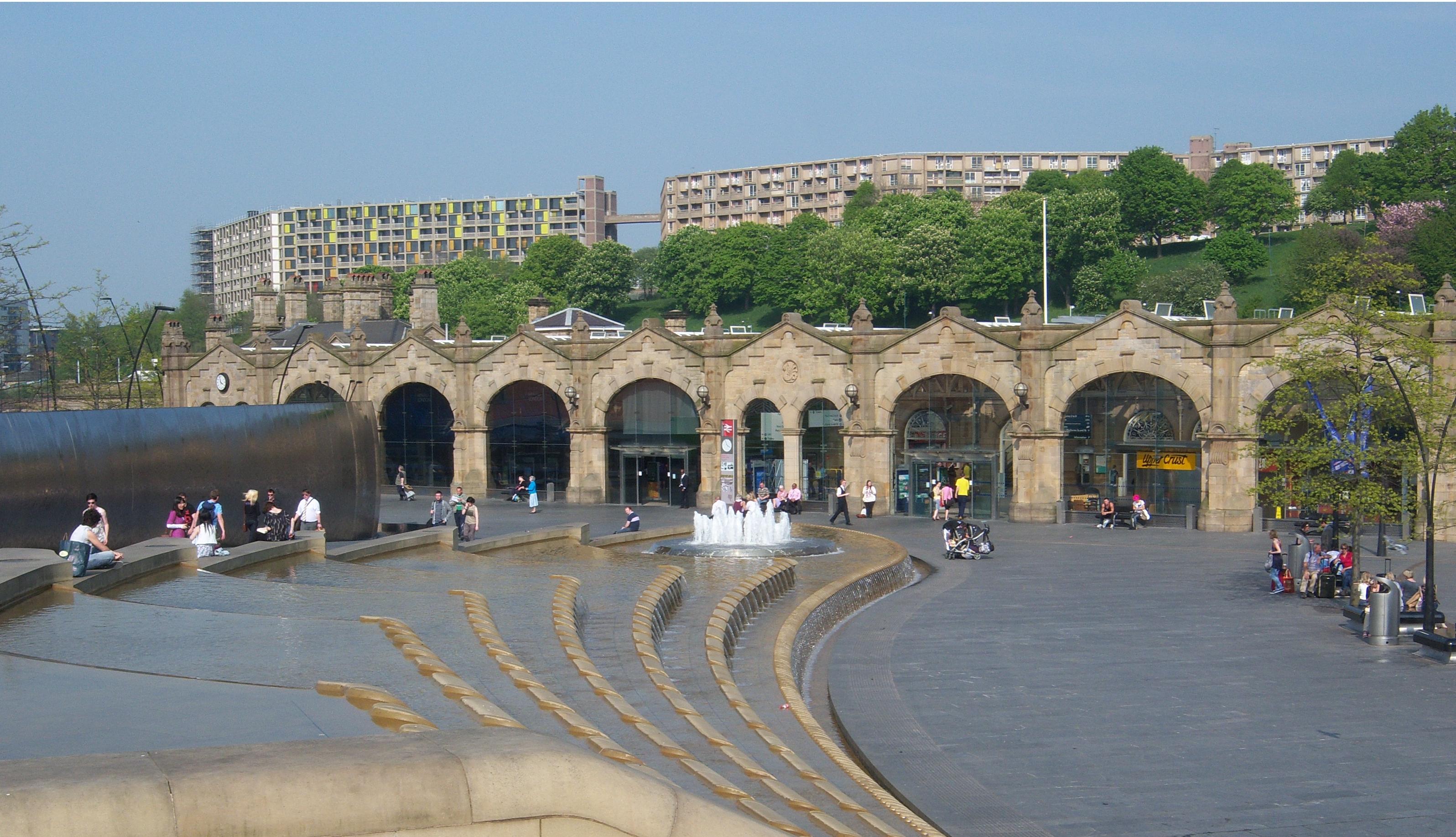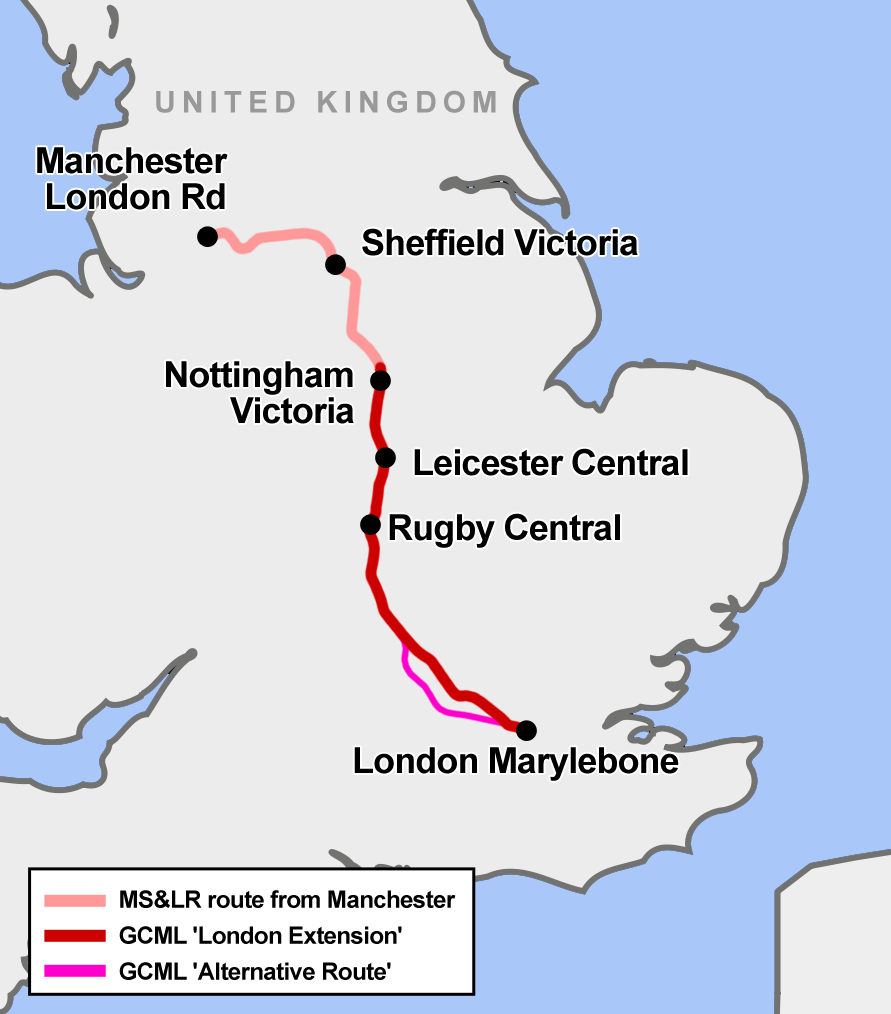|
Pleasley East Railway Station
Pleasley East is a former railway station in Pleasley, Derbyshire, England on the Nottinghamshire border near Mansfield. Context The station was built by the Great Northern Railway (GNR) as part of their Leen Valley Extension which enabled trains to run from Nottingham Victoria to Shirebrook North via Sutton-in-Ashfield Town, Skegby for Stanton Hill, Pleasley East and Shirebrook South. History The Leen Valley Extension started at Kirkby South Junction where it left the Great Central Main Line. It was opened northwards in stages, with passenger services as far as Skegby commencing with some fanfare on 4 April 1898. The line through Pleasley station opened for mineral traffic as far as Shirebrook Colliery on 26 November 1900. Passenger services were extended north of Skegby to Pleasley and Shirebrook (later renamed "Shirebrook South") on 1 November 1901. The high embankment through the village of Shirebrook which completed the Leen Valley Extension by connecting the GNR ... [...More Info...] [...Related Items...] OR: [Wikipedia] [Google] [Baidu] |
Pleasley
Pleasley is a village and civil parish with parts in both Derbyshire and Nottinghamshire. It lies between Chesterfield and Mansfield, south east of Bolsover, Derbyshire, England and north west of Mansfield, Nottinghamshire. The River Meden, which forms the county boundary in this area, runs through the village. The bulk of the village is in the Derbyshire district of Bolsover, and constitutes a civil parish of the same name. The population of this civil parish at the 2011 Census was 2,305. The part in Nottinghamshire is in the district of Mansfield and is unparished. Pleasley is not mentioned in Domesday when it was part of Glapwell parish. Buildings The parish church of St. Michael is built of squared sandstone and is believed to originate from the 12th century, as it includes a 12th-century chancel arch and font. There are also features from the 13th and 14th century, and evidence of significant restoration in the 19th century, when it was re-roofed in Welsh slate. A new s ... [...More Info...] [...Related Items...] OR: [Wikipedia] [Google] [Baidu] |
Shirebrook South Railway Station
Shirebrook South is a former railway station in Shirebrook, north eastern Derbyshire, England. See also There have been four separate stations with "Shirebrook" in their names: *Shirebrook South which is the subject of this article * Shirebrook North which was actually in Langwith Junction, * Shirebrook Colliery (later renamed Shirebrook Colliery Sidings) for colliery workmen's trains only, and *Shirebrook station which is on the Robin Hood Line. Shirebrook South, Shirebrook Colliery Sidings and Shirebrook North have been closed for many years. Shirebrook West closed in 1964 but reopened in 1998 as plain "Shirebrook". Shirebrook ''West'' was actually on the ''eastern'' edge of the village. Context The station was built by the GNR as part of their Leen Valley Extension which enabled trains to run from to via Sutton-in-Ashfield, Skegby, Pleasley and Shirebrook South. History The Leen Valley Extension started at Kirkby South Junction where it left the Great Central Main Lin ... [...More Info...] [...Related Items...] OR: [Wikipedia] [Google] [Baidu] |
Railway Stations In Great Britain Closed In 1931
Rail transport (also known as train transport) is a means of transport that transfers passengers and goods on wheeled vehicles running on rails, which are incorporated in tracks. In contrast to road transport, where the vehicles run on a prepared flat surface, rail vehicles (rolling stock) are directionally guided by the tracks on which they run. Tracks usually consist of steel rails, installed on sleepers (ties) set in ballast, on which the rolling stock, usually fitted with metal wheels, moves. Other variations are also possible, such as "slab track", in which the rails are fastened to a concrete foundation resting on a prepared subsurface. Rolling stock in a rail transport system generally encounters lower frictional resistance than rubber-tyred road vehicles, so passenger and freight cars (carriages and wagons) can be coupled into longer trains. The operation is carried out by a railway company, providing transport between train stations or freight customer facil ... [...More Info...] [...Related Items...] OR: [Wikipedia] [Google] [Baidu] |
Railway Stations In Great Britain Opened In 1901
Rail transport (also known as train transport) is a means of transport that transfers passengers and goods on wheeled vehicles running on rails, which are incorporated in tracks. In contrast to road transport, where the vehicles run on a prepared flat surface, rail vehicles (rolling stock) are directionally guided by the tracks on which they run. Tracks usually consist of steel rails, installed on sleepers (ties) set in ballast, on which the rolling stock, usually fitted with metal wheels, moves. Other variations are also possible, such as "slab track", in which the rails are fastened to a concrete foundation resting on a prepared subsurface. Rolling stock in a rail transport system generally encounters lower frictional resistance than rubber-tyred road vehicles, so passenger and freight cars (carriages and wagons) can be coupled into longer trains. The operation is carried out by a railway company, providing transport between train stations or freight customer facil ... [...More Info...] [...Related Items...] OR: [Wikipedia] [Google] [Baidu] |
Former Great Northern Railway Stations
A former is an object, such as a template, gauge or cutting die, which is used to form something such as a boat's hull. Typically, a former gives shape to a structure that may have complex curvature. A former may become an integral part of the finished structure, as in an aircraft fuselage, or it may be removable, being using in the construction process and then discarded or re-used. Aircraft formers Formers are used in the construction of aircraft fuselage, of which a typical fuselage has a series from the nose to the empennage, typically perpendicular to the longitudinal axis of the aircraft. The primary purpose of formers is to establish the shape of the fuselage and reduce the column length of stringers to prevent instability. Formers are typically attached to longerons, which support the skin of the aircraft. The "former-and-longeron" technique (also called stations and stringers) was adopted from boat construction, and was typical of light aircraft built until the ... [...More Info...] [...Related Items...] OR: [Wikipedia] [Google] [Baidu] |
Nottingham Railway Station
Nottingham station, briefly known as Nottingham City and for rather longer as Nottingham Midland, is a railway station and tram stop in the city of Nottingham. It is the principal railway station of Nottingham. It is also a nodal point on the city's tram system, with a tram stop that was originally called Station Street but is now known as Nottingham Station. The station was first built by the Midland Railway (MR) in 1848 and rebuilt by the same company in 1904, with much of the current building dating from the later date. It is now owned by Network Rail and managed by East Midlands Railway (EMR). Besides EMR trains, it is also served by CrossCountry and Northern trains and by Nottingham Express Transit (NET) trams. The station was one of several that once served the city of Nottingham. Amongst these were the city centre stations of on the Great Central Railway, and on the Great Northern Railway; both of these stations are now closed. A number of minor stations served l ... [...More Info...] [...Related Items...] OR: [Wikipedia] [Google] [Baidu] |
Spinkhill Railway Station
Spinkhill railway station is a disused railway station in Spinkhill, Derbyshire, England. History The station was built by the Lancashire, Derbyshire and East Coast Railway on their Beighton Branch, within sight of the northern portal of Spinkhill Tunnel. It opened in 1898 and closed to regular timetabled passenger traffic in 1939, though start and end of term special trains for pupils at the nearby Mount St Mary's College Mount St Mary's College is an independent, co-educational, day and boarding school situated at Spinkhill, Derbyshire, England. It was founded in 1842 by the Society of Jesus (better known as the Jesuits), and has buildings designed by notable ar ... continued for some years thereafter. The line through the station was closed as a through route on 9 January 1967 but trains continued to serve the nearby Westthorpe Colliery until it closed in 1984. This involved using the former running lines and the sidings behind the station house. Modern times The hu ... [...More Info...] [...Related Items...] OR: [Wikipedia] [Google] [Baidu] |
Sheffield Railway Station
Sheffield station, formerly ''Pond Street'' and later ''Sheffield Midland'', is a combined railway station and tram stop in Sheffield, England; it is the busiest station in South Yorkshire. Adjacent is Sheffield station/Sheffield Hallam University Sheffield Supertram stop. In 2017–18, the station was the 43rd-busiest in the UK and the 15th-busiest outside London. History 1870 - 1960 The station was opened in 1870 by the Midland Railway to the designs of the company architect John Holloway Sanders. It was the fifth and last station to be built in Sheffield city centre. The station was built on the 'New Line', which ran between Grimesthorpe Junction, on the former Sheffield and Rotherham Railway, and Tapton Junction, just north of Chesterfield. This line replaced the Midland Railway's previous route, the 'old road', to London, which ran from Sheffield Wicker via Rotherham. The new line and station were built despite some controversy and opposition locally. The Duke of Norf ... [...More Info...] [...Related Items...] OR: [Wikipedia] [Google] [Baidu] |
Great Central Main Line
The Great Central Main Line (GCML), also known as the London Extension of the Manchester, Sheffield and Lincolnshire Railway (MS&LR), is a former railway line in the United Kingdom. The line was opened in 1899 and built by the Great Central Railway running from Sheffield in the North of England, southwards through Nottingham and Leicester to Marylebone in London. The GCML was the last main line railway to be built in Britain during the Victorian period. Built by the railway entrepreneur Edward Watkin with the aim to run as a fast trunk route from the North and the East Midlands to London and the south of England. Initially not a financial success, it recovered under the leadership of Sam Fay. Although initially planned for long-distance passenger services, in practice the line's most important function became to carry goods traffic, notably coal. In the 1960s, the line was considered by Dr Beeching as an unnecessary duplication of other lines that served the same places, especial ... [...More Info...] [...Related Items...] OR: [Wikipedia] [Google] [Baidu] |
Skegby Railway Station
Skeby railway station served the village of Skegby, Nottinghamshire in England. Context The station was built by the Great Northern Railway (GNR) as part of their Leen Valley Extension which enabled trains to run from Nottingham Victoria to Shirebrook North via Sutton-in-Ashfield Town, Skegby, Pleasley East and Shirebrook South. History The Leen Valley Extension started at Kirkby South Junction where it left the Great Central Main Line. It was opened northwards in stages, with passenger services as far as Skegby commencing with some fanfare on 4 April 1898. The line through Pleasley station opened for mineral traffic as far as Shirebrook Colliery on 26 November 1900. Passenger services were extended north of Skegby to Pleasley and Shirebrook (later renamed "Shirebrook South") on 1 November 1901. The high embankment through the town of Shirebrook which completed the Leen Valley Extension by connecting the GNR's Shirebrook (later "Shirebrook South") and the LD&ECR' ... [...More Info...] [...Related Items...] OR: [Wikipedia] [Google] [Baidu] |
Bolsover (borough)
Bolsover District is a local government district in Derbyshire, England. It is named after the town of Bolsover, which is near the geographic centre of the district, but the council is based in Clowne. At the 2011 Census, the district had a population of 75,866. The district is along with North East Derbyshire, Borough of Chesterfield and Bassetlaw District is a non-constituent member of the Sheffield City Region. Town and parish councils There are fourteen town and parish councils within the district. In addition to the town councils of Old Bolsover and Shirebrook, there are the parish councils of: *Ault Hucknall *Barlborough *Blackwell *Clowne *Elmton-with-Creswell *Glapwell *Hodthorpe and Belph *Pinxton *Pleasley *Scarcliffe *South Normanton *Tibshelf * Whitwell Other settlements include Broadmeadows, Hilcote, Langwith, Old Blackwell, Newton, Palterton, Shirebrook and Westhouses. The current district boundaries date from 1 April 1974, when the urban district of Bolso ... [...More Info...] [...Related Items...] OR: [Wikipedia] [Google] [Baidu] |







